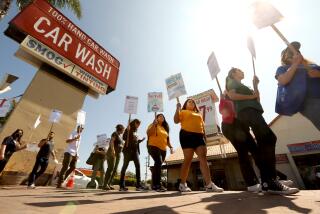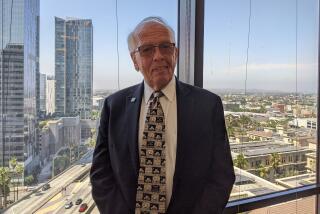Blood and Money
- Share via
Scientific and political controversies have coincided in Sacramento to postpone, and perhaps kill, legislation to extend the use of paid donors of blood platelets, which are small cells used in several types of surgery. The subject is too serious to dismiss in this way.
The problem is complex. Platelets are in short supply. The Red Cross Blood Bank serving Los Angeles and Orange counties estimates the demand at 40,000 units a year. The Red Cross now supplies 10,000 to 15,000 units and hopes to expand to 38,000 units by 1993. HemaCare, a commercial enterprise, supplies about 4,000 units a year. But the HemaCare operation may be curtailed next year. Unlike the Red Cross and most blood collectors, it pays $50 per donation. So does the Scripps Clinic in La Jolla. Legislation permitting payment for this particular blood product expires at the end of the year. At that time, the law will revert to legislation that allows payment of donors only when there is no blood from volunteer donors. Even in the face of an obvious shortage, proving the absence of volunteer-donated supplies can raise difficult legal questions.
It was those legal questions that prompted passage of the legislation on platelets in the first place. But the political maneuvering by the bill’s sponsor, Assemblyman Tom Bane (D-Tarzana), and signs of a conflict of interest in another of his medical legislative initiatives, have cast a political cloud over the issue. Indeed, the cloud is so dense that Assemblyman William J. Filante (R-Greenbrae), the only physician in the Legislature, has dropped legislation to authorize continued use of paid donors for platelets.
Nearly all of the blood used in hospitals is collected from volunteer donors. This practice was inspired initially by concern for higher risks of hepatitis in those selling blood, who might be less than candid about their medical histories. The concern has been compounded by the risk of spreading the human immunodeficiency virus (HIV) that causes AIDS. But there also has been praise for both HemaCare and the Scripps Clinic which, experts say, apply standards at least as high as those of the volunteer blood banks. “As long as HemaCare can demonstrate that it is offering a good product, the issue of paying is irrelevant,” says Dr. Edgar Engleman, director of the Stanford Medical Center blood bank.
Platelets, for many years used primarily in the treatment of leukemia, now are more widely used. There are two sources. Routine blood-bank donations of whole blood can be processed to remove platelets; the donations of six or eight donors can be combined to compose a unit. But the preferred approach is to use a single donor whose blood is drawn through an apheresis machine, a process that takes two to three hours.
The use of a single donor reduces the risk of infection to the blood recipient inherent in pooled platelets from multiple donors. A donor can safely give platelets every few days rather than every eight weeks, as with whole blood, so a relatively small pool of carefully screened people can supply a large number of units. The inconvenience of the apheresis process is a substantial barrier, however, and has encouraged the payment plans now in effect. The problem of supply is compounded by the fact that the platelets can be safely stored no longer than five days.
We think California would be well served by extending legislation permitting paid donors for three more years. This would provide time to enlarge the volunteer donor pool. The hospitals that rely on paid donor platelets will be in an even better position then to advise the Legislature on the wisdom of the exception. In the meantime, it is noteworthy that the American Blood Commission, the key organization working for a safe and adequate blood supply, has chosen not to oppose the use of paid donors for platelets.
More to Read
Get the L.A. Times Politics newsletter
Deeply reported insights into legislation, politics and policy from Sacramento, Washington and beyond. In your inbox twice per week.
You may occasionally receive promotional content from the Los Angeles Times.










